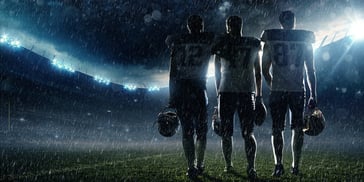 Athletics have a significant representation among American manufacturers who produce outdoor equipment for recreation and sports. Football is one pastime that has a particularly high economic impact with its scope of interest from pee-wee flag football leagues, to high schools playing under Friday night lights, to the NFL broadcasted to millions each week. In addition to the many areas you’ll find industrial yarn and thread in a football stadium, the manufacturing of outdoor athletic equipment that supports the game such as nets, tarps and mats are an important aspect to the proficiency and safety of players and fans.
Athletics have a significant representation among American manufacturers who produce outdoor equipment for recreation and sports. Football is one pastime that has a particularly high economic impact with its scope of interest from pee-wee flag football leagues, to high schools playing under Friday night lights, to the NFL broadcasted to millions each week. In addition to the many areas you’ll find industrial yarn and thread in a football stadium, the manufacturing of outdoor athletic equipment that supports the game such as nets, tarps and mats are an important aspect to the proficiency and safety of players and fans.
With outdoor athletic equipment manufacturing, many factors come into place with regard to durability, sustainability, UV protection, mildew resistance and more. Manufacturers should look for a high-tenacity, resilient and continuous filament thread that is specifically designed for demanding outdoor applications. When choosing the best thread for athletic equipment application, it’s best to first distinguish if the UV and environmental exposures will be occasional or prolonged. In most cases, polyester and nylon threads work equally well.
Here are a few key areas of consideration when choosing a thread for the production of outdoor athletic nets, tarps, mats and more.
Physical properties of thread:
- Thread size impacts multiple aspects of the production process
- Larger threads are typically higher in strength, but have less yield per pound
- Larger threads also require a large needle size and can increase the visibility of the stitch
- Elastic modulus is the ability of a given thread to recover its original length immediately after an applied force has been released
- The elasticity of a sewing thread affects the strength and the finished quality of a stitched seam
- A typical Polyester thread stretches about 20% before it breaks. Nylon has even better elastic and abrasion resistance properties than polyester
- When seam elasticity is not desirable, alternative materials are available to provide the combination of strength and flexibility you need
Colorfastness:
- If colorfastness is important to your application, you might consider using a solution dyed material
- Solution dyed material is made by incorporating the pigment or dye into the base polymer during extrusion. This method results in a material that is colored completely through as opposed to a surface treatment resulting from a package dyeing process
- The downside to a solution dyed product is that your options for custom colors can be limited
UV Resistance:
- Outdoor materials require threads that can withstand severe weathering conditions and require properties such as UV resistance, high strength, and resistance to abrasion in order to extend its life
- Polyester is the most common thread for outdoor applications because it is inherently UV resistant and can withstand direct exposure longer than nylon while still retaining the majority of its strength
- In the presence of UV rays, Nylon will break down and start to degrade, yellow and become brittle quickly if untreated
- Polyester and nylon can be treated to further improve their UV resistance
If you take part in sports equipment manufacturing for nets, padding, storage bags and other outdoor athletic gear, it is essential to choose a sewing thread that incorporates the physical, colorfastness and UV resistance properties needed to maintain a durable and sustainable design.
Get a 50-yard line view of how Service Thread industrial yarn and thread is represented in the sports equipment market and how it helps your favorite team win.



